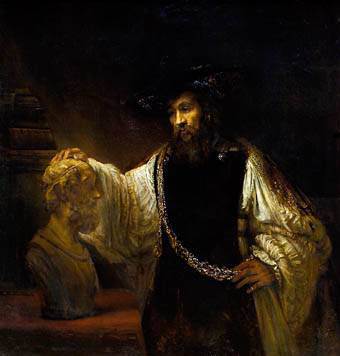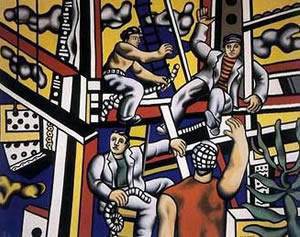
Rembrandt: “Aristotle contemplating a bust of Homerus”
Landmark Age of Rembrandt Exhibition Puts Met’s Entire Dutch Paintings Collection of 228 Works on View in September
Exhibition dates: September 18, 2007 – January 6, 2008
Exhibition location: Special Exhibition Galleries, 2nd floor
Press Preview: Monday, September 10, 10:00 a.m. – noon
]]>
The Age of Rembrandt: Dutch Paintings in The Metropolitan Museum of Art will present, for the first time, all of the Metropolitan Museum’s 228 Dutch paintings (dating mostly from the 1600s), widely considered the greatest collection of Dutch art outside Europe. Normally, only about 100 Dutch paintings are on view in the Museum. This comprehensive exhibition will provide a unique opportunity for visitors to view the collection of Dutch paintings as a whole. The exhibition also commemorates the 400th anniversary year of Rembrandt’s birth and coincides with the publication of the first complete catalogue of Dutch paintings in the Metropolitan Museum.
The Metropolitan Museum of Art owns 20 paintings by Rembrandt van Rijn (including such famous works as Aristotle with a Bust of Homer and his Self-portrait of 1660), 11 paintings by Frans Hals, and five of the 35 known paintings by Johannes Vermeer. Also in the collection are exceptional groups of Dutch landscape painting (by Jacob van Ruisdael, Meindert Hobbema, Aelbert Cuyp, and other masters) and of genre pictures (scenes of everyday life), still lifes, marine views, portraits, and historical and biblical subjects. Masters who have recently been the subjects of monographic exhibitions in other museums – such as Gerard ter Borch and Pieter de Hooch – are richly represented in the Metropolitan Museum’s collection. Many of these works never leave the Museum.
The exhibition is made possible by Accenture.
Exhibition Overview
The exhibition will take place in 12 galleries and will present the Museum’s entire collection of Dutch paintings (ca. 1600-1800) in approximate order of acquisition, from the founding purchase of 1871, to the major gifts and bequests of the 1880s through the 1940s, and finally to the strategic accessions of the 1950s onward. Reflecting how the Museum’s great collection of Dutch paintings is closely linked with the institution’s history, the installation will outline how the collection was formed, following the taste for Dutch art in America and among New York’s great collectors.
Many of the 174 paintings acquired in the “1871 Purchase” made by the Museum were from the Dutch school, including masterworks such as Jan van Goyen’s View of Haarlem and the Haarlemmer Meer and Salomon van Ruysdael’s Drawing the Eel. These paintings were coveted on both sides of the Atlantic and secured the young Museum an “enviably solid foundation for future acquisition and development,” as Henry James wrote in a well-known essay published in the Atlantic Monthly in the summer of 1872.
Despite the Museum’s ambitious beginnings, not many paintings were acquired for another decade, due to one of the worst depressions in American history, which took place in 1873. Over the next ten years, however, industry boomed in America, trade flourished, and the rise of private income gave way to the new millionaires of the Gilded Age (ca. 1875-1900). The most important collectors of this period for the Museum – such as Henry Marquand, J. P. Morgan, and Louisine and H. O. Havemeyer – sought out masterpieces by Rembrandt, Hals, Vermeer, Ruisdael, among other Dutch artists. Dutch pictures had been favored by collectors in England, France, and Germany throughout the 19th century, but their appeal in the United States was intensified by the notion that American values – democracy, closeness to nature, family life, and the “Protestant ethic” of hard work – were anticipated by the middle-class society of the Dutch Republic. During this period, Rembrandt’s Self-portrait, Vermeer’s Young Woman with a Water Jug and A Maid Asleep, Hals’s Merrymakers at Shrovetide, Portrait of a Man, Young Man and Woman in an Inn (“Yonker Ramp and his Sweetheart”), Van Ruisdael’s Wheatfields and Aelbert Cuyp’s Young Herdsman with Cows all entered the Museum’s collection.
The contributions of later collectors and contributors – such as Benjamin Altman (whose Rembrandts, Halses, and early Vermeer will be grouped together in one grand gallery), Arabella Huntington, William K. Vanderbilt, Jules Bache, Mr. and Mrs. Charles Wrightsman, and Jack and Belle Linsky – and of curators and directors, will be acknowledged frequently throughout the exhibition. The last gallery will feature works acquired since about 1960, including Aristotle with a Bust of Homer, the only Rembrandt painting ever purchased by the Metropolitan Museum, Vermeer’s Study of a Young Woman, Steen’s The Dissolute Household, and De Witte’s Interior of the Old Church in Delft
Follow us on:


